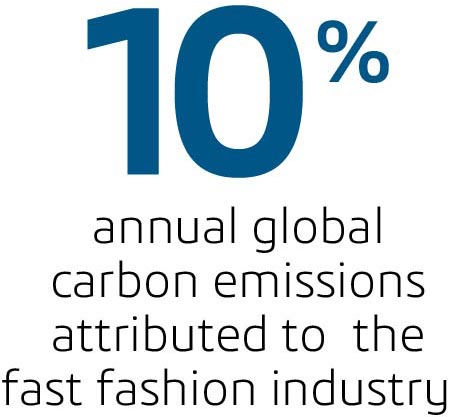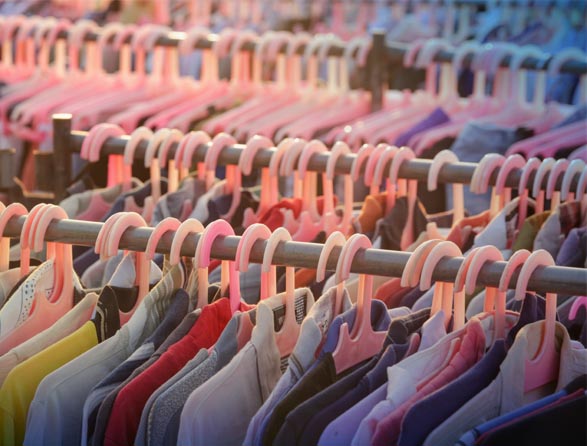New seasons, new styles, buying more, and buying cheap are the wave of the fashion industry in recent years. The fast fashion industry is rapidly growing, with the number of garments made each year doubling in the past 20 years and the global consumption of fashion increasing by 400%.
Although financially successful, this industry has contributed significantly to the climate crisis, accounting for an estimated 10% of global carbon dioxide emissions. Despite the growth of the fast fashion industry, consumers have indicated that sustainability has become a key priority for them, so how do we shift this profitable cycle of mass consumption to long-term sustainability for our planet?
What is fast fashion?
Fast fashion is a manufacturing process involving the production of garments in bulk in as little time as possible. The fast fashion industry was estimated to be worth $41.15 billion in 2023, with an anticipated reach of $59.85 billion by 2030. So why can’t we continue on this trend of mass consumption?
In today’s fast-paced world, the allure of fast fashion can be undeniable. New trendy styles at pocket-friendly prices are delivered quickly to your doorstep through e-tailors. However, behind the convenience and discounted prices, fast fashion’s rapid production relies heavily on cheap labor and unsustainable manufacturing processes. From the excessive use of water and exploitation of workers, fast fashion’s environmental impact can be devastating, not to mention harmful social and economic implications. The Facts and Figures about Materials, Waste, and Recycling Report in 2018 reported that landfills received 11.3 million in textiles, with the generation of textiles reaching 17 million tons.

Harmful effects of fast fashion
The environmental impact
The fast fashion industry accounts for 10% of annual global carbon emissions in the Sustainability and Circularity in the Textile Value Chain March 2023 Report. This report details how today’s garments have doubled since 2000, with consumers buying 60% more clothes but wearing them for half as long. To keep the cost of production down, fast fashion uses cheap materials like polyester, a nonrenewable fossil fuel. Polyester can take over 200 years to decompose and lasts only seven to 10 wears on average.
In short, fast-fashion garments are not sustainable for the wearer or the planet. Many consumers have become concerned with fast fashion’s environmental impact and are looking for more sustainable fashion options.
The social impact
Fast fashion is not just affordable because of the cheap materials used but because working conditions are often less than ideal. Behind the glamor of cheap runway styles, fast fashion production sometimes heavily involves unsafe working conditions and low wages in developing countries. Major department stores often outsource from developing countries with weak labor laws such as Cambodia, Bangladesh, and Myanmar. Myanmar, for example, experienced violent riots in 2017, with workers making an average of $2.63 a day. Historically, about 80% of workers around the globe in the fashion industry are women paid through a piece rate system at meager wages. In Bangladesh, the second largest exporter of garments in the world, the conditions became so unsafe that 1,134 workers were killed after the Rana Plaza garment factory collapsed in 2018.
“Overproduction rides on the back of the most vulnerable people along the fast fashion supply chain, who are usually from the Global South,” Sammy Oteng, senior community engagement manager for the Or Foundation, told Vogue. The Or Foundation is a public charity on a mission to catalyze a justice-led circular economy in the fashion industry.
The fast fashion industry produces cheap products for consumers, but the environment and workers pay these costs on the back end.
What is the sustainable fashion industry?
Sustainable fashion is a term for ethically made clothes that are designed and produced to be more environmentally friendly. This includes clothes made from natural fibers such as cotton, hemp, linen, wool, and silk.
Slow fashion offers a deliberate and mindful approach to clothing, unlike fast fashion. Rooted in sustainability and ethical production, slow fashion encourages consumers to buy made-to-last pieces. It is a conscious lifestyle choice that prevents waste and overproduction in the industry.
Shifting consumer mindset toward sustainable fashion
The fast fashion business model of quick turnover and garments at low prices is under pressure from consumers interested in change. According to a ThredUp survey from 2021, there is increasing awareness among consumers of the issues of sustainability in the fashion industry; 74% of shoppers were aware their consumption habits significantly impact the planet, and 50% believed fast fashion to be harmful to the environment. With growing awareness of the sustainability issues in this industry, consumers will increasingly seek environmentally friendly options in the future.
One way consumers support sustainable fashion is by actively choosing to buy fewer pieces – and buying pieces designed to last. Another implication of shifting consumer mindset involves reimagining the idea of ownership in apparel through the leasing and renting clothing. Business models such as Rent the Runway’s support reuse instead of rapid consumption. In this type of model, garments are reused and shared among customers, reducing the demand for new production and minimizing waste. Customers can enjoy the latest trends by renting designer pieces for special occasions or everyday wear without contributing to environmental or societal impacts.
Four ways the sustainable fashion market is making strides
1. Recycling in a circular economy
We are already witnessing the signs of the fashion industry transitioning toward a more circular model. Once clothes are no longer used, they are reinvited into new clothes through textile recycling in a circular economy. Blue Jeans Go Green is a program implemented to collect denim across the US before it reaches landfills to recycle it into Ultra Touch Denim Insulation. Circ is a technology system that also promotes a circular economy by returning clothes to their raw materials to be made into new fabrics; retraining these fibers retain the value of the garment instead of simply discarding it.
2. Reuse of materials
When large companies in the fashion industry adopt sustainability practices, it sets off a ripple effect that extends far beyond their operations. Adidas was ranked No.3 in global sales in the Apparel/Accessories category in Forbes World’s Largest Public Companies List. It committed in 2024 to using only recycled plastics, doing away with all virgin polyester, after having massive success with recycled plastic footwear, projecting to sell 11 million pairs this year. Sustainable commitments from a company of this size will influence over 900 million items produced and bought. Adidas’ sustainable shift has broader ramifications, pushing other large companies like Nike to move toward a more sustainable future aggressively. Nike and Adidas have since collaborated to create sustainable footwear from plastic water bottles found in oceans.
3. Use of sustainable materials
Sustainable fashion involves shifting the materials used toward natural fibers such as cotton, hemp, linen, wool and silk. These are durable materials meant to last longer. Using cheaper materials, like polyester, to make these products requires fossil fuels, which do not biodegrade and sit in landfills and water systems. In producing made-to-last garments from sustainable materials, we ensure more long-lasting pieces and a substantially smaller environmental impact on production and consumption.
4. Charitable donations for change
Brands can also directly support sustainable fashion through charitable donations to work toward a greener world. Patagonia announced in 2022 that it is transforming the company into a charitable trust, with all profits from its $1.5 billion annual sales going toward climate change. This makes the planet their only shareholder. A company already committed to sustainability practices, winning the UN Champion of the Earth World in 2019, went a step further to contribute directly to the battle against climate change.

Allegations of greenwashing in the fashion industry
Fast fashion brands have been criticized for advertising their green initiatives widely despite those initiatives comprising a tiny part of their overall operations. This process is known as greenwashing, a misleading advertising technique to lure consumers. The critics suggest that companies paint sustainable line launches from fast fashion brands as tactics to make the brand appear more environmentally friendly while the bulk of its business remains rapidly producing garments from fossil fuels and aiding mass consumption.
The future of fashion
Fast fashion’s environmental impact cannot be understated with the depletion of non-renewable resources, emission of greenhouse gases, and the use of large amounts of water and energy. It is time to change the future of fashion through recycling, reuse, sustainable practices, and donations toward a better future.
Tools like the 3DEXPERIENCE platform give companies more transparency across the product lifecycle – from sourcing all the way through production, distribution and recycling – and help streamline processes to support sustainability goals.
Virtual twins could help clothing designers understand how more sustainable materials will behave in a garment and help support better, more sustainable alternatives.
